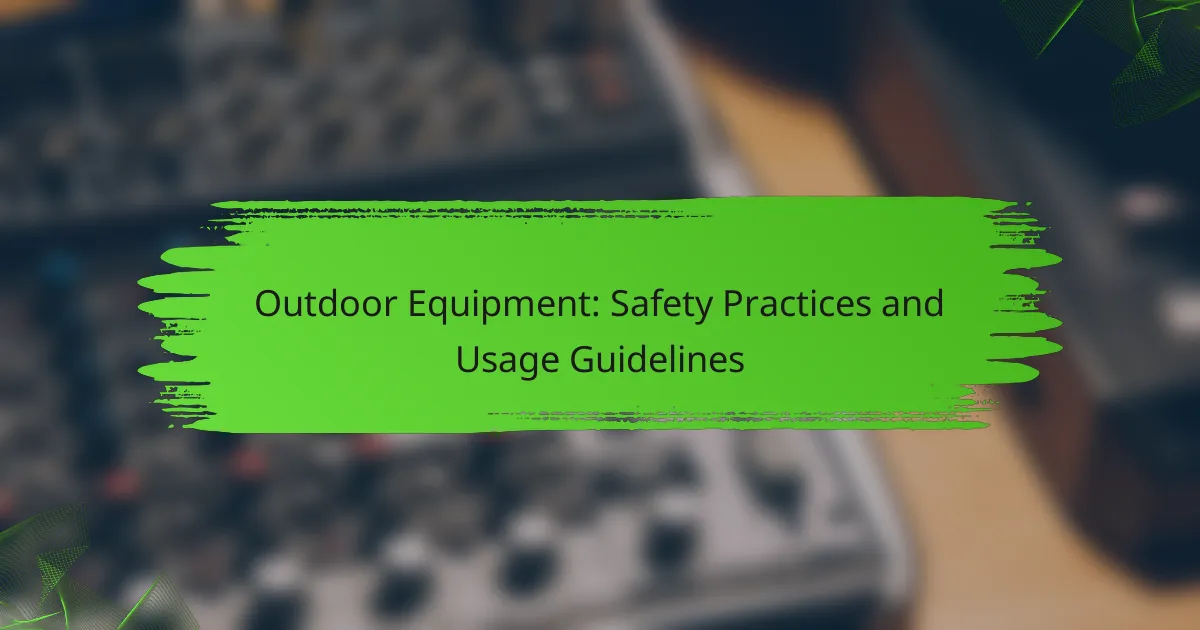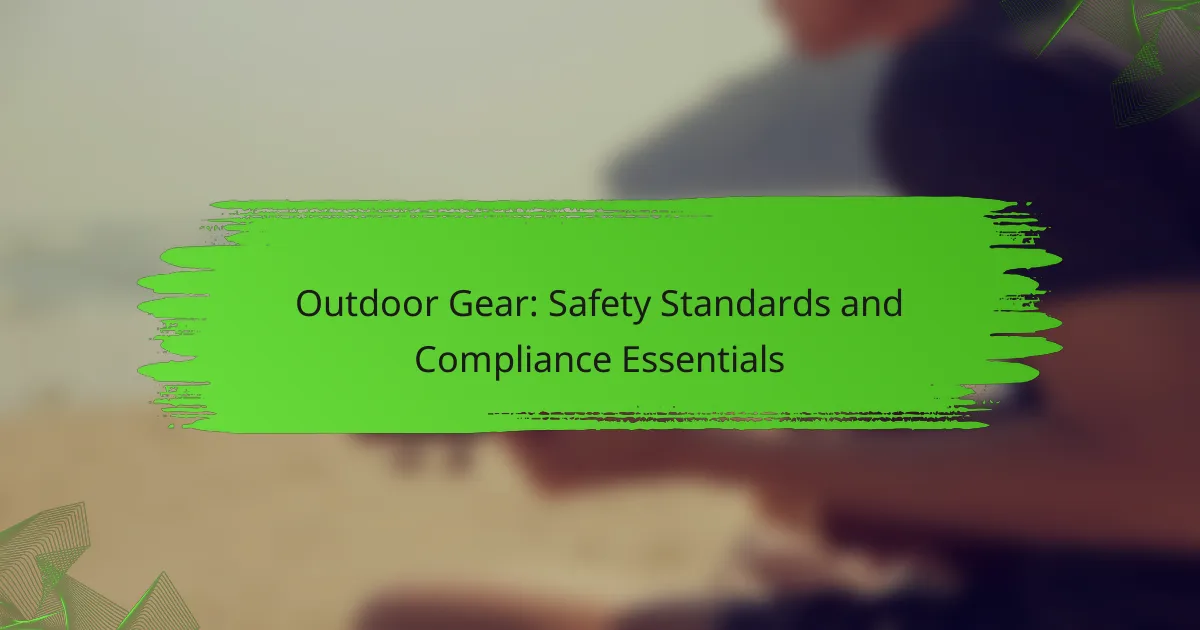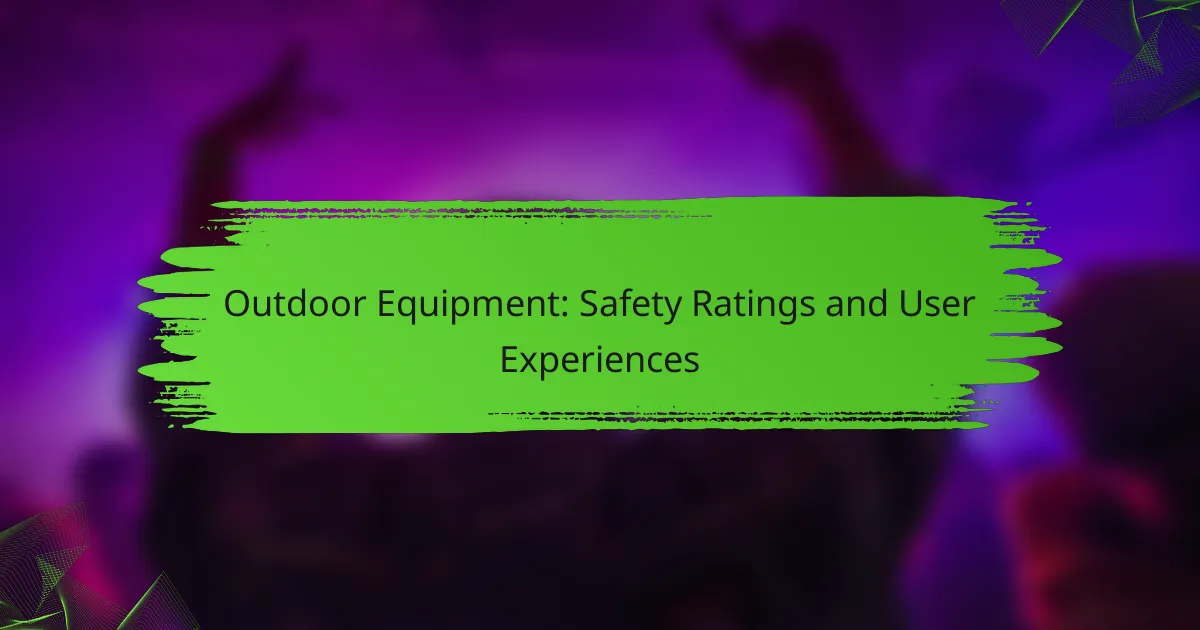Ensuring safety while using outdoor equipment is essential for a successful adventure. By following best practices such as regular inspections, proper storage, and using appropriate safety gear, you can significantly reduce the risk of accidents. Additionally, understanding usage guidelines and choosing the right equipment tailored to your needs will enhance both safety and enjoyment in your outdoor pursuits.

What are the best safety practices for outdoor equipment?
The best safety practices for outdoor equipment include regular inspections, proper storage, using safety gear, understanding weather conditions, and being prepared for emergencies. These practices help ensure equipment functions correctly and safely, reducing the risk of accidents.
Regular equipment inspections
Conducting regular inspections of outdoor equipment is crucial for safety. Check for signs of wear, damage, or malfunction before each use. This includes examining straps, hinges, and any moving parts to ensure they are in good working condition.
Establish a routine inspection schedule, ideally before each outing. Keeping a checklist can help ensure you don’t miss any critical components during your checks.
Proper storage techniques
Proper storage of outdoor equipment protects it from damage and prolongs its lifespan. Store items in a cool, dry place, away from direct sunlight and moisture, which can cause deterioration.
Use protective covers or cases for sensitive equipment, and organize items to prevent them from becoming tangled or damaged. Label storage areas for easy access and inventory management.
Use of safety gear
Wearing appropriate safety gear is essential when using outdoor equipment. This includes helmets, gloves, goggles, and other protective clothing suited to the activity.
Ensure that all safety gear fits properly and is in good condition. Regularly check for wear and replace items as needed to maintain optimal protection during use.
Understanding weather conditions
Being aware of weather conditions is vital for safe outdoor activities. Check forecasts before heading out and be prepared to adjust plans based on changing weather, such as storms or extreme temperatures.
Consider the impact of weather on equipment performance. For instance, wet conditions may affect traction, while high winds can pose risks with certain gear. Always prioritize safety over convenience.
Emergency preparedness
Emergency preparedness is a key aspect of outdoor safety. Always carry a first aid kit and know basic first aid procedures relevant to your activities. Familiarize yourself with emergency contact numbers and local resources.
Develop a plan for various scenarios, such as equipment failure or severe weather. Inform someone of your itinerary and expected return time, and consider carrying a communication device for emergencies.

How to choose the right outdoor equipment?
Choosing the right outdoor equipment involves understanding your specific needs based on the activity, evaluating the materials for durability, and considering user feedback. Prioritizing these factors ensures safety, comfort, and enjoyment during your outdoor adventures.
Consider the activity type
The type of outdoor activity significantly influences the equipment you need. For instance, hiking requires sturdy footwear and a reliable backpack, while camping necessitates a tent and cooking gear. Identifying the primary activities you plan to engage in will help narrow down your choices.
Different activities may also have specific gear requirements. For example, climbing gear must meet safety standards, while fishing equipment should be lightweight and easy to carry. Always match your equipment to the intended use for optimal performance.
Evaluate durability and materials
Durability is crucial when selecting outdoor equipment, as it impacts longevity and safety. Look for materials that withstand harsh conditions, such as waterproof fabrics for tents or high-grade aluminum for hiking poles. Equipment made from these materials typically lasts longer and performs better in challenging environments.
Consider the trade-offs between weight and durability. While lightweight materials are easier to carry, they may not be as robust. Assess your priorities based on the length of your trips and the conditions you expect to encounter.
Check user reviews and ratings
User reviews and ratings provide valuable insights into the performance and reliability of outdoor equipment. Look for products with a high number of positive reviews, as they often indicate a proven track record. Pay attention to comments regarding specific features that matter to you, such as comfort or ease of setup.
Be cautious of overly positive reviews that may seem biased. A balanced view, including both pros and cons, can help you make a more informed decision. Websites and forums dedicated to outdoor enthusiasts can be excellent resources for gathering this information.
Assess weight and portability
Weight and portability are essential factors, especially for activities like backpacking or hiking. Aim for equipment that balances functionality with lightweight design. For example, a compact tent may save space and weight, making it easier to carry on long treks.
Consider the total weight of your gear, as it can add up quickly. A good rule of thumb is to keep your pack weight below 20% of your body weight for comfort during extended trips. Always test how the equipment feels when packed to ensure it meets your portability needs.

What are the usage guidelines for specific outdoor equipment?
Usage guidelines for outdoor equipment ensure safety and enhance the overall experience. Understanding how to properly set up, maintain, and utilize gear is crucial for outdoor activities.
Tent setup and maintenance
When setting up a tent, choose a flat, dry area free from sharp objects and debris. Ensure that the tent is staked down securely to withstand wind and rain. Regularly check for wear and tear, and clean the tent after use to prolong its lifespan.
During maintenance, inspect seams and zippers for damage and apply waterproofing treatments as needed. Store the tent in a cool, dry place to prevent mold and mildew growth.
Proper usage of climbing gear
Climbing gear, such as harnesses, ropes, and carabiners, must be used according to manufacturer guidelines. Always inspect equipment for signs of wear before each use, and replace any damaged items immediately.
When climbing, ensure that all gear is properly secured and that knots are tied correctly. Familiarize yourself with the specific techniques for belaying and rappelling to enhance safety during climbs.
Guidelines for camping stoves
Camping stoves should be used in well-ventilated areas to prevent carbon monoxide buildup. Always follow the manufacturer’s instructions for setup and operation, including fuel type and usage limits.
Keep flammable materials away from the stove and monitor cooking closely. Allow the stove to cool before packing it away, and regularly check for leaks or damage to ensure safe operation.
Best practices for hiking backpacks
When using a hiking backpack, ensure it fits properly to distribute weight evenly across your body. Adjust the straps so that the pack sits snugly against your back without causing discomfort.
Pack essential items at the top or in easily accessible pockets, and keep heavier items closer to your back for better balance. Regularly check the pack for wear and ensure zippers and straps are functioning correctly to avoid issues on the trail.

What are the common risks associated with outdoor equipment?
Common risks associated with outdoor equipment include injury from improper use, equipment failure, and environmental hazards. Understanding these risks can help users take necessary precautions to ensure safety during outdoor activities.
Injury from improper use
Improper use of outdoor equipment can lead to serious injuries, such as cuts, bruises, or fractures. For instance, not following the manufacturer’s instructions when using tools or gear can result in accidents.
To minimize the risk of injury, always read the user manual and familiarize yourself with the equipment before use. Practice safe handling techniques and ensure that all users are trained properly.
Equipment failure
Equipment failure can occur due to wear and tear, lack of maintenance, or manufacturing defects. This can lead to accidents, especially in critical situations like climbing or boating.
Regularly inspect your gear for signs of damage and perform routine maintenance. For example, check ropes for frays, ensure that safety harnesses are intact, and replace batteries in electronic devices as needed.
Environmental hazards
Outdoor activities expose users to various environmental hazards, including extreme weather, wildlife encounters, and unstable terrain. These factors can significantly increase the risk of accidents.
To mitigate these risks, stay informed about weather conditions and local wildlife. Carry appropriate gear for protection, such as weather-resistant clothing and bear spray, and always choose safe paths when hiking or biking.



